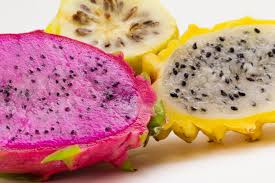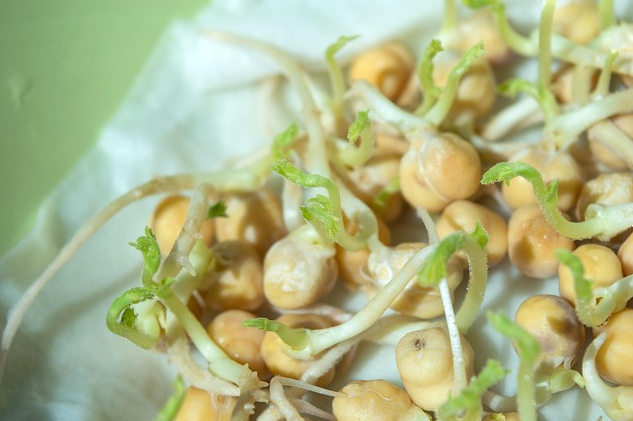Those that make any fruit platter professional, and any salad tropical and juicy?
There are fruits that come in pairs of colors -white and red grapes (yes, there is also the muscat in between), apples and bananas come in a whole array of colors, and all the other examples that come to mind regarding colors are vegetables: onions, cabbage… This important philosophical issue crossed my mind as I walked around the store, around the pitayabasket, and the smell of guavas following my every steps. Without noticing I began to hum "Once there were two roses… One white and the other red…" although the pitayas were purple and yellow, but the ides is the same.
The pitaya, also called "dragon fruit" or "dragon egg", grows on a cactus, and has a special and impressive bloom – both because the flower itself is very beautiful, and because it opens at night, and is available for pollination by creatures with less opportunities for a delicious treat – bats, moths as well as manual pollination. So, if you see a neighbor wandering through his cactus patch at night, wearing gloves and armed with a syringe – it could well be that he didn't do anything criminal, but just pollinated his pitayas.
The most common type of pitaya are those with the pink and green peel, and white colored flesh, dotted with tiny black dots. Other species, which are slightly less common, have flesh in phosphorescent pink, purple, or white – and a yellow peel. The taste can be described as a combination of melon, kiwi, and pear, with a hint of berries… Pitayas will last for about a week in autumn weather, so if you rather look at it a little longer before attacking it with an ice cream spoonor turning it into an exquisite fruit salad -it should be stored in a bag in the fridge. The pitayas are very easy to operate (sort of like kiwi, passion fruit, or avocado): cut into halves or quarters, and scrape out the contents easily with a spoon.
Organic Pattaya, yellow or pink, is not only suitable for eating as it is (although this is definitely a recommended way) – In the less likely case that you are tired of eating it with a spoon, it will be a wonderful addition to a morning shake. If you make green shakes, the addition of pitaya will moderate the green flavors, adding sweetness and thick texture (much like the avocado does to green smoothies with banana). You can (and should!) use pitayas to make ice cream and jam, but it usually disappears from the fruit basket long before there is a chance to make something so complex from it.
The pitayas are a member in the superfoods pantheon. They contain a whole spectrum of vitamins, minerals and antioxidants. The Chinese have incorporated them into the traditional diet as a means to encourage and improve digestive activity, and balance blood cholesterol. The Chinese legend tells of the origin of the pitaya as follows: The pitaya was created thousands of years ago by a fire-breathing dragon. In the battle against the dragon, after the dragon was defeated, the soldiers would attack him and take out the fruit of the dragon – The Pitaya, and present it to the Emperor as a signal of the crushing victory in battle (the continuation of the legend is that afterwards they would also eat the dragon, to gain his strength, but we won’t go there here). Today, in the era of severe dragon shortage, there are only scientific means and researches left – and these indicate that consumption of pitaya may help the body protect itself from certain types of cancer and diabetes. The red color in it, same as the tomato, is due to the high lycopene content, which is of course a powerful antioxidant. But beyond all these – It's simply delicious.
Yours,
Maggie's Garden Team
Forecast:
In the ORGANIC vegetable baskets we expect (draft only):
Cucumber
Tomato
Lettuce
Potato
Beet
Onion
Parsley
Pumpkin
Spinach
The LARGE organic vegetable baskets also include:
Eggplant
Coriander
Sweet potatoe
In the ORGANIC fruit baskets:
Sweetie
Orange
Banana
The large ORGANIC fruit baskets also include:
Dates – Brhai
Red grapefruit
New! New! The ORGANIC Green Basket:
Swiss chard
Celery
Spinach
Basil
Dill
A kind of lettuce
Mint
Sprouts












